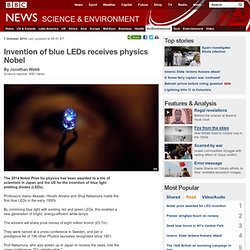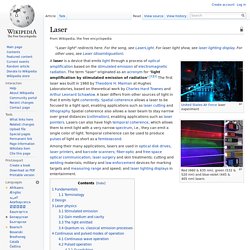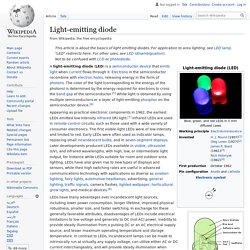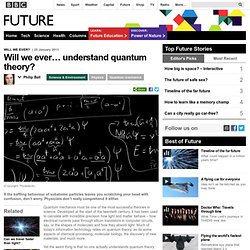

Invention of blue LEDs wins physics Nobel. 7 October 2014Last updated at 05:51 ET By Jonathan Webb Science reporter, BBC News The 2014 Nobel Prize for physics has been awarded to a trio of scientists in Japan and the US for the invention of blue light emitting diodes (LEDs).

Professors Isamu Akasaki, Hiroshi Amano and Shuji Nakamura made the first blue LEDs in the early 1990s. By combining blue light with existing red and green LEDs, this enabled a new generation of bright, energy-efficient white lamps. The winners will share prize money of eight million kronor (£0.7m). Can We Really Touch Anything?
Luminiscence. Lectures. Rentgenstari. Laser. Red (660 & 635 nm), green (532 & 520 nm) and blue-violet (445 & 405 nm) lasers Among their many applications, lasers are used in optical disk drives, laser printers, and barcode scanners; fiber-optic and free-space optical communication; laser surgery and skin treatments; cutting and welding materials; military and law enforcement devices for marking targets and measuring range and speed; and laser lighting displays in entertainment.

Fundamentals Lasers are characterized according to their wavelength in a vacuum. Most "single wavelength" lasers actually produce radiation in several modes having slightly differing frequencies (wavelengths), often not in a single polarization. Although temporal coherence implies monochromaticity, there are lasers that emit a broad spectrum of light or emit different wavelengths of light simultaneously. Terminology Laser beams in fog, reflected on a car windshield Design Components of a typical laser: 1. Laser physics Stimulated emission Gain medium and cavity. Chapter 3 - StumbleUpon. Classical physics could not explain the spectra of black bodies.

It predicted that the intensity (power emitted at a given wavelength) of emitted light should increase rapidly with decreasing wavelength without limit (the "ultraviolet catastrophe"). In the figure below, the curve labeled "Rayleigh-Jeans law" shows the classically expected behavior. However, the measured spectra actually showed an intensity maximum at a particular wavelength, while the intensity decreased at wavelengths both above and below the maximum. In order to explain the spectra, in 1900 the German physicist Max Planck (1858 - 1947) was forced to make a desperate assumption for which he had no physical explanation. As with classical physics, he assumed the body consisted of vibrating oscillators (which were actually collections of atoms or molecules).
E = hf (Planck's formula) In classical physics, the electromagnetic field connects charged particles to each other (see Sections 2.4, 2.6). 3.2. L=h/p 3.3. 3.4. Light-emitting diode. Parts of an LED.

Although unlabeled, the flat bottom surfaces of the anvil and post embedded inside the epoxy act as anchors, to prevent the conductors from being forcefully pulled out via mechanical strain or vibration. An LED is often small in area (less than 1 mm2) and integrated optical components may be used to shape its radiation pattern.[5] Appearing as practical electronic components in 1962,[6] the earliest LEDs emitted low-intensity infrared light. Infrared LEDs are still frequently used as transmitting elements in remote-control circuits, such as those in remote controls for a wide variety of consumer electronics. The first visible-light LEDs were also of low intensity, and limited to red. Early LEDs were often used as indicator lamps for electronic devices, replacing small incandescent bulbs.
Science & Environment - Will we ever… understand quantum theory? If the baffling behaviour of subatomic particles leaves you scratching your head with confusion, don’t worry.

Physicists don’t really comprehend it either. Quantum mechanics must be one of the most successful theories in science. Developed at the start of the twentieth century, it has been used to calculate with incredible precision how light and matter behave – how electrical currents pass through silicon transistors in computer circuits, say, or the shapes of molecules and how they absorb light. Much of today’s information technology relies on quantum theory, as do some aspects of chemical processing, molecular biology, the discovery of new materials, and much more.